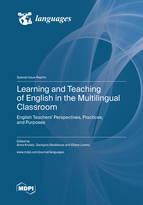Learning and Teaching of English in the Multilingual Classroom: English Teachers’ Perspectives, Practices, and Purposes
A special issue of Languages (ISSN 2226-471X).
Deadline for manuscript submissions: closed (31 August 2021) | Viewed by 33802
Special Issue Editors
Interests: multilingualism; language and identity; additional language acquisition; language learning and teaching; language teacher training
Interests: multilingualism; translanguaging; language learning and teaching; language teacher training; literacy; digital competence in teacher education
Interests: second and third language acquisition; acquisition of English; language learning and teaching; multilingualism; heritage bilinguals; (learner) corpus research
Special Issue Information
Dear Colleagues,
As linguistic diversity and multilingualism are on the rise around the globe, English language classrooms are becoming linguistic third spaces (Gutiérrez, Baquedano-Lopéz, and Tejeda, 2000) where multilingual learners and teachers interact. For learners, adding yet another language to their linguistic repertoires entails activation of their existing linguistic resources (May, 2013), engagement of performative competence (Canagarajah, 2013), and possible shifts in linguistic identity (Pavlenko and Blacklegde, 2004). Teachers, on the other hand, are increasingly expected to implement pedagogical approaches that recognize diverse linguistic and cultural practices as valuable resources (Bonnet and Siemund, 2018), engage learners’ whole language repertoires (Cenoz and Gorter, 2014), promote additive multilingualism, and forge opportunities for meaningful and equal participation and language development for all students (García and Flores, 2012; Leung and Valdes, 2019).
While the multilingual turn in language education has been embraced by researchers and academics, empirical findings from classroom research continue to suggest that teachers working in multilingual settings find it difficult to implement pedagogies that meet the needs of linguistically diverse, multilingual learners (Alisaari, Heikkola, Commins, and Acquah, 2019; de Angelis, 2011; Rodríguez-Izquierdo, Gonzàlez Falcón, and Goenechea Permisán, 2020; Webster and Valeo, 2011). Recent research studies reported the lack of appropriate pedagogical training in how to optimize the student learning experience in similar settings (Rasheed, Zeeshan, Zaidi, 2017; Raud and Orehhova, 2020). For instance, the wide spectrum of mother tongues encountered in multilingual classrooms that teachers have little to no knowledge about often hinders the implementation of flexible languaging approaches, thus constituting a barrier to a multilingual development. Teachers, however, are important agents of change, and a full transition to multilingually-oriented teaching practices cannot be enacted without them. In the classroom, it is often teachers who decide to what degree they want to implement existing language policies, and, as a result, their actions can either support or suppress multilingual practices of their students (Hornberger and Cassels, 2007).
Because of the key role educators can play in optimizing the learning experience of multilingual learners, there is a need for more studies in different classroom environments that would shed light on how the students’ linguistic repertoires could be effectively integrated in the teaching of English as an additional language (Koonj, Memon, and Shah, 2020; Shin, Dixon, and Choi, 2020). In many parts of the world, English is the first foreign language children learn in school; yet, for many learners, it is not the second language they acquire, but instead a third or additional language (Bonnet, Jacob, Schäfer, and Schmidt, 2018). Research on the acquisition of English in multilingual contexts to date has focused on a range of issues, including the competence of multilingual users to acquire the languages they know, acquisition throughout the life span, the opportunities and challenges presented by multilingualism, cross-linguistic influences in multilingual language acquisition, the relationship between the multilingual individual and the multilingual society, and the impact of power relations on acquisition. However, despite the growing body of research in this area, more studies are needed on English teachers’ beliefs about multilingualism and the pedagogical practices they enact to foster multilingual development of their learners.
This Special Issue aims to compile papers that examine English teachers’ perspectives, practices, and purposes on the current challenges in linguistically diverse classrooms. Topics of interest include, but are not limited to, the following: early language learning, adult language learning, multilingual competence with English as an additional language, multilingual literacy in the English language classroom, pedagogical approaches to teaching English in multilingual contexts, translingual practices in multilingual English classrooms, multidisciplinary approaches to multilingual teaching the integration of mother tongue(s) in multilingual education, and multilingual assessment. We are particularly interested in a global perspective and welcome contributions from all geographical locations.
We request that, prior to submitting a manuscript, interested authors initially submit a proposed title and an abstract of 400–600 words summarizing their intended contribution. Please send it to the Guest Editors (anna.m.krulatz@ntnu.no; georgios.neokleous@ntnu.no; eliane.lorenz@ntnu.no) or to the Languages Editorial Office (languages@mdpi.com). Abstracts will be reviewed by the Guest Editors for the purposes of ensuring proper fit within the scope of the Special Issue. Full manuscripts will undergo double-blind peer-review.
The tentative completion schedule is as follows:
- Abstract submission deadline: 31 January 2021
- Notification of abstract acceptance: 28 February 2021
- Full manuscript deadline: 31 August 2021
References:
Alisaari, J., Heikkola, L. M., Commins, N., & Acquah, E. O. (2019). Monolingual ideologies confronting multilingual realities. Finnish teachers’ beliefs about linguistic diversity. Teaching and Teacher Education, 80(1), 48–58.
Bonnet, A., Jacob, L., Schäfer, A., & Schmidt, J. (2018). The acquisition of English as an L3 from a sociocultural point of view. The perspective of multilingual learners. In Bonnet, A., & Siemund, P. (Eds.), Foreign language education in multilingual classrooms (pp. 255-280). Amsterdam, the Netherlands: John Benjamins.
Bonnet, A., & Siemund, P. (Eds.). (2018). Foreign language education in multilingual classrooms. Amsterdam, the Netherlands: John Benjamins.
Canagarajah, S. (2013). Translingual practice. Global Englishes and cosmopolitan relations. London, England: Routledge.
Cenoz, J., & Gorter, D. (2014). Focus on multilingualism as an approach in educational contexts. In A. Creese, & A. Blackledge (Eds.), Heteroglossia as practice and pedagogy (pp. 239-254). Berlin, Germany: Springer.
De Angelis, G. (2011). Teachers’ beliefs about the role of prior language knowledge in learning and how these influence teaching practices. International Journal of Multilingualism, 8(3), 216-234.
García, O., & Flores, N. (2015). Multilingual pedagogies. In M. Martin-Jones, A. Blackledge, & A. Creese (Eds.), The Routledge handbook of multilingualism (pp. 232-246). London, England: Routledge.
Gutiérrez, K. D., Baquedano-Lopéz, P., & Tejeda, C. (2000). Rethinking diversity: Hybridity and hybrid language practices in the third space. Mind, Culture, and Activity, 6(4), 148-164.
Hornberger, N. H., & Cassels Johnson, D. (2007). Slicing the onion ethnographically: Layers and spaces in multilingual language education policy and practice. TESOL Quarterly, 41(3), 509-532.
Koonj, N., Memon, S., & Shah, S. W. A. (2020). English Language Teaching in Multilingual Classrooms: A Study of L2 Teachers’ Strategies to Manage Many Languages. English Language Teaching, 64, 1-15.
Leung, C., & Valdés, G. (2019). Translanguaging and the transdisciplinary framework for language teaching and learning in a multilingual world. The Modern Language Journal, 103(2), 348-370.
May, S. (Ed.). (2013). The multilingual turn: Implications for SLA, TESOL, and bilingual education. New York, NY: Routledge.
Pavlenko, A., & Blackledge, A. (2004). Introduction: New theoretical approaches to the study of negotiation of identities in multilingual contexts. In A. Pavlenko, & A. Blackledge, (Eds.), Negotiation of identities in multilingual contexts (pp. 1-33). Clevedon, England: Multilingual Matters.
Rasheed, S., Zeeshan, M., & Zaidi, N. A. (2017). Challenges of teaching English language in a multilingual setting: An investigation at government girls’ secondary schools of Quetta, Baluchistan, Pakistan. International Journal of English Linguistics, 7(4), 149-157.
Raud, N., & Orehhova, O. (2020). Training teachers for multilingual primary schools in Europe: key components of teacher education curricula. International Journal of Multilingualism. DOI: 10.1080/14790718.2020.1718678
Rodríguez-Izquierdo, R. M., Gonzàlez Falcón, I., & Goenechea Permisán, C. (2020). Teacher beliefs and approaches to linguistic diversity. Spanish as a second language in the inclusion of immigrant students. Teaching & Teacher Education, 90, 103035.
Shin, J. Y., Dixon, L. Q., & Choi, Y. (2020). An updated review on use of L1 in foreign language classrooms. Journal of Multilingual and Multicultural Development, 41(5), 406-419.
Webster, N. L., & Valeo, A. (2011). Teacher preparedness for a changing demographic of language learners. TESL Canada Journal, 28(2), 105-128.
Prof. Anna Krulatz
Dr. Georgios Neokleous
Dr. Eliane Lorenz
Guest Editors
Manuscript Submission Information
Manuscripts should be submitted online at www.mdpi.com by registering and logging in to this website. Once you are registered, click here to go to the submission form. Manuscripts can be submitted until the deadline. All submissions that pass pre-check are peer-reviewed. Accepted papers will be published continuously in the journal (as soon as accepted) and will be listed together on the special issue website. Research articles, review articles as well as short communications are invited. For planned papers, a title and short abstract (about 100 words) can be sent to the Editorial Office for announcement on this website.
Submitted manuscripts should not have been published previously, nor be under consideration for publication elsewhere (except conference proceedings papers). All manuscripts are thoroughly refereed through a double-blind peer-review process. A guide for authors and other relevant information for submission of manuscripts is available on the Instructions for Authors page. Languages is an international peer-reviewed open access monthly journal published by MDPI.
Please visit the Instructions for Authors page before submitting a manuscript. The Article Processing Charge (APC) for publication in this open access journal is 1400 CHF (Swiss Francs). Submitted papers should be well formatted and use good English. Authors may use MDPI's English editing service prior to publication or during author revisions.
Keywords
- multilingualism
- English
- additional language acquisition
- language learning
- language teaching
- diverse learners
- teachers’ beliefs








